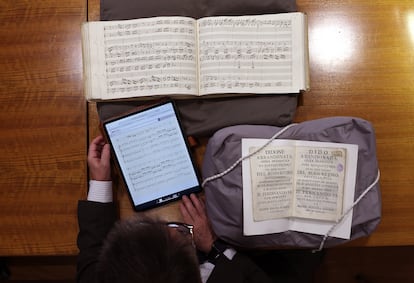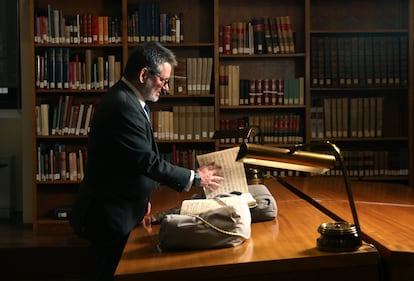What does sadness sound like? The ‘key’ is in 18th century opera
The Didone Project analyzes more than 3,000 arias from 200 different operas to discover what emotions sound like


Music speaks, but what it says often depend on the listener. Even so, there are certain registers and patterns that, with some exceptions, work for everyone. If a song is in a minor mode, it tends to sound sad, and if it’s in a major mode, it tends to sound happy. Starting from this basic observation, the Complutense Institute of Musical Sciences and the Department of Musicology at the Complutense University of Madrid, with funding from the European Research Council, have analyzed over 3,000 arias from 200 18th-century opera scores to study what emotions sound like. They’ve discovered that joy is in D major and involves trumpets, that love sounds like string instruments, often accompanied by flutes, and that hate tends to have a fast tempo. The arias, 90% of them previously unreleased to the public, are part of the Didone Project, which was launched in a private beta version last Thursday and will be available to the public on the project’s website on April 12.
The aim of the project is to explore how human emotions are expressed through music. Álvaro Torrente, director of the Complutense Institute of Musical Sciences, explains: “Research on this subject is typically conducted in a subjective way: playing music to a group of listeners, then asking each one to describe what emotion it produces. And this can be one way, but, in my opinion, it’s too subjective. We start from the premise that the expressing emotions involves a process of encoding, produced mainly through music with text and music with action.” This is where opera comes in. To further narrow down their study, the team decided to use only works accompanied by text and written by the great librettist of the 18th century: Pietro Metastasio. “He might not be one of the most recognized names today, but during his time, he was a god. Any composer who wanted to pursue a career in opera had to start by setting Metastasio to music. There are several librettos that had more than a hundred different musical versions. It’s unparalleled. Imagine having a hundred versions of La traviata or The Marriage of Figaro. He exercised absolute mastery over the operatic scene,” Torrente says.
The 18th century also saw the consolidation of a type of opera that was directly related to Descartes’ The Passions of the Soul, a treatise written in dedication to an aristocrat who wanted to know how to control her emotions. “In the end,” says José María Domínguez, one of the project’s researchers,” what Descartes studies is behavior. He says that emotions are inevitable, but that the way to control them is to understand them. That’s why he explains them using a Cartesian lens, and this ordered system of examining and understanding the passions is used to classify the arias. This is why we give the classification so much importance, because in the end, it has a musical implication in that it reflects how composers think about the action that’s represented, and how the public perceives it. It’s not an intellectual process, it’s that they participate in what happens to the singers.” That is to say, the audience experiences the emotion that the protagonist sings, and the opera thus becomes a kind of school of emotions that can provide clues about how people loved, hated or cried in the 18th century.

What were these opera performances like? They were shows with big-name stars where an audience of different social classes would mix together in a theater. “It’s like the movies are today. Opera was the most popular kind of show for aristocrats and lower classes alike. It was an interclass meeting point,” says Domínguez. It was in these spaces that listeners began to establish shared codes that in subsequent centuries would become established through repetition, creating a musical language that we all now understand. “A very simple way to explain it,” Domínguez says, “is that the major mode is associated with happiness and the minor mode with sadness. That coding has a lot to do with the 18th century. These are cultural conventions, of course, because if you go to China this doesn’t work. No Chinese person would associate the minor mode with sadness.”
Omnipresent anger
But theory does not always align with practice. Ana Llorens, the project’s scientific director, explains: “The use of tonalities and modes in the 18th century is surprising. If we look at the treatises, it seems like it’s all very codified, that a given tonality serves to express a given emotion. But when you analyze the music, it’s not so clear-cut. The major mode is used for absolutely everything, happy or sad. Although it’s true that the minor mode is always used for sadness. G major seems to be more associated with slightly softer emotions, and D major more warlike, but the rest can be associated with any type of emotion.” This finding points to the fact that the foundations of these codes were starting to be formed in the 18th century, and would grow more established in subsequent ones.
According to the team’s findings, a single musical parameter is rarely associated with a particular emotion — more often, it’s a combination of elements. For example, if an aria is in a minor key and has ternary measures and moderate tempos, it’s very likely to express sadness. If it’s in major key and has no trumpets, but strings (and sometimes flutes as well), the aria is likely to express love. Moreover, the researchers found that the emotion most present in all of these operas is anger, though beyond a fast tempo, they have yet to identify a direct correlation between this emotion and specific musical characteristics. “One of the things that happens is that there are very few joyful arias, because the operas are all complex, so we find that this emotion is almost always expressed in the final chorus,” Torrente adds.
In publishing all these arias, the Didone Project has created a platform that will allow musicians, musicologists and amateurs alike to search the scores by composer, the emotion they express, the tonality, the instruments used, and so on. On Thursday, coinciding with the 300th anniversary of the premiere of Metastasio’s first opera, a beta version of the database was published to allow a group of experts in the field to test it and identify possible errors. On April 12, the date of the librettist’s death, they will open the website to the public. Llorens explains that they designed the platform primarily for academic use: “If someone is interested in the arias, they can read and study them here, but to perform them, they must consult with us first, because the works are subject to copyright.” Torrente concludes: “Many extraordinary composers have been forgotten. I think it will be a surprise and, above all, a magnificent opportunity for the singers.”
Sign up for our weekly newsletter to get more English-language news coverage from EL PAÍS USA Edition
Tu suscripción se está usando en otro dispositivo
¿Quieres añadir otro usuario a tu suscripción?
Si continúas leyendo en este dispositivo, no se podrá leer en el otro.
FlechaTu suscripción se está usando en otro dispositivo y solo puedes acceder a EL PAÍS desde un dispositivo a la vez.
Si quieres compartir tu cuenta, cambia tu suscripción a la modalidad Premium, así podrás añadir otro usuario. Cada uno accederá con su propia cuenta de email, lo que os permitirá personalizar vuestra experiencia en EL PAÍS.
¿Tienes una suscripción de empresa? Accede aquí para contratar más cuentas.
En el caso de no saber quién está usando tu cuenta, te recomendamos cambiar tu contraseña aquí.
Si decides continuar compartiendo tu cuenta, este mensaje se mostrará en tu dispositivo y en el de la otra persona que está usando tu cuenta de forma indefinida, afectando a tu experiencia de lectura. Puedes consultar aquí los términos y condiciones de la suscripción digital.
More information
Archived In
Últimas noticias
‘How does it feel to be a failure?’: Elizabeth Berkley’s journey from ‘Showgirls’ ridicule to vindication
The story of the Málaga virus: The code that haunted Google’s cybersecurity center director for 30 years
The impact of Ecuador’s mega-prison: A polluted river, cleared forests and military checkpoints
Corinne Low: ‘I’m more concerned about the female happiness gap than the gender wage gap’
Most viewed
- The low-cost creative revolution: How technology is making art accessible to everyone
- Christian Louboutin: ‘Young people don’t want to be like their parents. And if their parents wear sneakers, they’re going to look for something else’
- All the effects of gentrification in one corner of Mexico’s Colonia Roma
- Liset Menéndez de la Prida, neuroscientist: ‘It’s not normal to constantly seek pleasure; it’s important to be bored, to be calm’
- Christmas loses its festive spirit: ICE fears cast shadow over religious celebrations










































